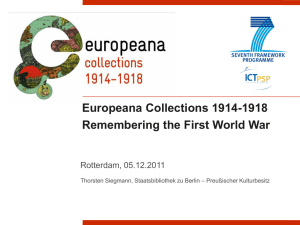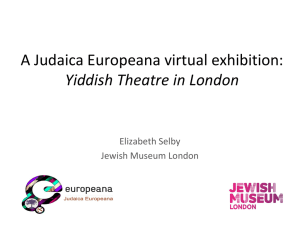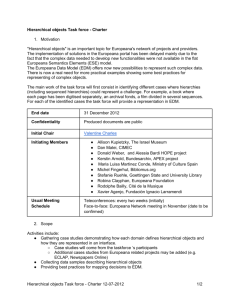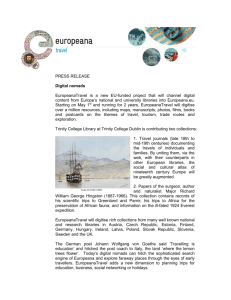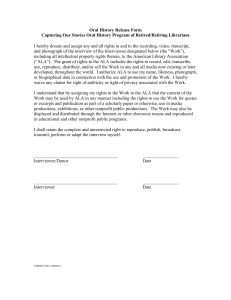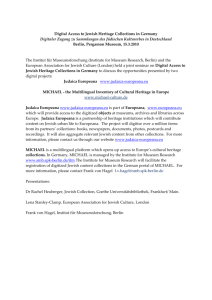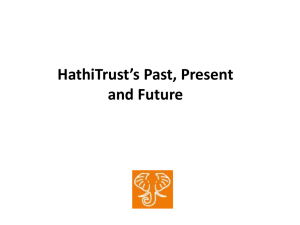MEMORANDUM To: DPLA Governance Workstream From
advertisement
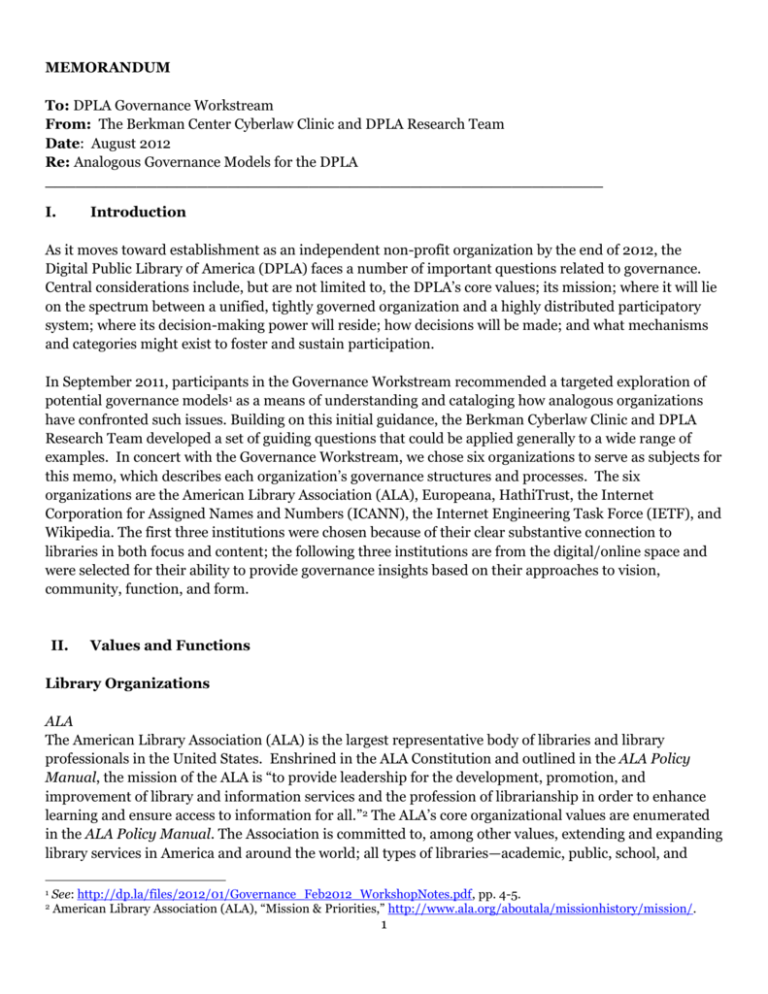
MEMORANDUM To: DPLA Governance Workstream From: The Berkman Center Cyberlaw Clinic and DPLA Research Team Date: August 2012 Re: Analogous Governance Models for the DPLA _______________________________________________________ I. Introduction As it moves toward establishment as an independent non-profit organization by the end of 2012, the Digital Public Library of America (DPLA) faces a number of important questions related to governance. Central considerations include, but are not limited to, the DPLA’s core values; its mission; where it will lie on the spectrum between a unified, tightly governed organization and a highly distributed participatory system; where its decision-making power will reside; how decisions will be made; and what mechanisms and categories might exist to foster and sustain participation. In September 2011, participants in the Governance Workstream recommended a targeted exploration of potential governance models1 as a means of understanding and cataloging how analogous organizations have confronted such issues. Building on this initial guidance, the Berkman Cyberlaw Clinic and DPLA Research Team developed a set of guiding questions that could be applied generally to a wide range of examples. In concert with the Governance Workstream, we chose six organizations to serve as subjects for this memo, which describes each organization’s governance structures and processes. The six organizations are the American Library Association (ALA), Europeana, HathiTrust, the Internet Corporation for Assigned Names and Numbers (ICANN), the Internet Engineering Task Force (IETF), and Wikipedia. The first three institutions were chosen because of their clear substantive connection to libraries in both focus and content; the following three institutions are from the digital/online space and were selected for their ability to provide governance insights based on their approaches to vision, community, function, and form. II. Values and Functions Library Organizations ALA The American Library Association (ALA) is the largest representative body of libraries and library professionals in the United States. Enshrined in the ALA Constitution and outlined in the ALA Policy Manual, the mission of the ALA is “to provide leadership for the development, promotion, and improvement of library and information services and the profession of librarianship in order to enhance learning and ensure access to information for all.”2 The ALA’s core organizational values are enumerated in the ALA Policy Manual. The Association is committed to, among other values, extending and expanding library services in America and around the world; all types of libraries—academic, public, school, and 1 2 See: http://dp.la/files/2012/01/Governance_Feb2012_WorkshopNotes.pdf, pp. 4-5. American Library Association (ALA), “Mission & Priorities,” http://www.ala.org/aboutala/missionhistory/mission/. 1 special; all librarians, library staff, trustees and other individuals and groups working to improve library services; member service; an open, inclusive, and collaborative environment; and intellectual freedom. The ALA constitution states that the object of the ALA is “to promote library service and librarianship.”3 The ALA’s core functions are aligned with and categorized under eight “Key Action Areas,” which serve as guiding principles for directing the Association’s energies and resources. The ALA Council first approved five of these areas in 1998; the Council has reviewed and revised these areas annually since. With the development of strategic plans in 2000, 2005, and 2010, the original five areas have been expanded to the eight that presently guide the organization.4 These are: advocacy for libraries and the profession; diversity; education and lifelong learning; equitable access to information and library services; intellectual freedom; literacy; organizational excellence; and transforming libraries.5 Another key function of the ALA is engagement with policy and regulatory issues that may be of interests to libraries and librarians. The organization’s policy approach is guided by the ALA Policy Manual, which is an extensive list of policy positions and resolutions, some of which have little to do with the provision of library services.6 The ALA maintains an Office of Government Relations in Washington, DC, with the express aim of “tracking and influencing legislation, policy, and regulatory issues of importance to the library fields and its publics.”7 Europeana Europeana is a cross-domain cultural heritage portal funded by the European Commission that facilitates access to over 23 million digitized cultural objects in Europe,8 including books, manuscripts, maps, paintings, films, museum objects, archival records, and other digital materials.9 Europeana operates as a clearinghouse between consumers and content providers. Europeana’s content comes from a network of more than 1,500 cultural heritage institutions that provide metadata either directly or via aggregators in order to facilitate access to locally stored objects.10 Europeana’s mission is to enable “people to explore the digital resources of Europe’s museums, libraries, archives and audio-visual collections… [and to] promote discovery and networking opportunities in a multilingual space where users can engage, share in and be inspired by the rich diversity of Europe’s cultural and scientific heritage.”11 The Europeana Foundation, Europeana’s governing body, codified the pan-European digital library’s mission and vision statements into five overarching objectives in the 2010 Articles of Association, a formal legal statement governing their operations. Europeana’s five core functions are: ALA, “Mission, Priority Areas, Goals,” American Library Association Policy Manual, Section 1 § 2-5, http://www.ala.org/aboutala/governance/policymanual/updatedpolicymanual/tableofcontents#section1. 4 ALA, “History of Key Action Areas,” http://www.ala.org/aboutala/missionhistory/keyactionareas/history. 5 ALA, “Mission, Priority Areas, Goals,” American Library Association Policy Manual, Section 1 § 4, http://www.ala.org/aboutala/governance/policymanual/updatedpolicymanual/tableofcontents#section1. 6 Ibid., Section 2, http://www.ala.org/aboutala/governance/policymanual/updatedpolicymanual/tableofcontents#section2 7 ALA, “Offices,” http://www.ala.org/offices/. 8 Europeana Professional, “Facts & Figures,” http://www.pro.europeana.eu/web/guest/about/facts-figures. 9 Europeana Professional, “FAQs,” http://pro.europeana.eu/web/guest/europeana-faq. 10 Europeana Professional, “Aggregators and Providers,” http://pro.europeana.eu/web/guest/aggregators-and-providers. 11 WP1 EuropeanaNet, Jill Cousins, Harry Verwayen, Mel Collie, “Outline Business Plan for Europeana as a service of the EDL Foundation,” Europeana Document Library (2008), http://version1.europeana.eu/c/document_library/get_file?uuid=0c6c6078-8026-4297-9367dd6d14b73c2e&groupId=10602. 3 2 To provide access to Europe's cultural and scientific heritage by way of a crossdomain portal; to facilitate formal agreement across museums, archives, audiovisual archives and libraries on how to co-operate in the delivery and sustainability of a joint portal; to stimulate and facilitate initiatives to bring together existing content; to support and facilitate digitisation of Europe’s cultural and scientific heritage, and; all that which is connected or which could be conductive to the above, in the widest sense of the word.12 In addition to facilitating access to digital objects, Europeana has sought to address some of the key obstacles facing the digital heritage industry, including legal issues of the public domain, linked open data, and user engagement. They have done so through funded research, a strategic focus on the part of Europeana staff, Europeana Task Forces, and Europeana Projects, which are targeted working groups comprised of Europeana’s data providers that conduct research and perform outreach on specific topics.13 In terms of political involvement, Europeana is funded by the European Commission and partially by its member states’ ministries of culture and education. The Executive Committee communicates strategy and financial reporting to the Funding and Orientation Group of the European Commission Member States Expert Group, an intergovernmental subgroup of the European Commission’s Digital Libraries Initiative which holds some degree of jurisdiction over Europeana’s financial standing.14 Europeana Awareness, a “Best Practice” network led by the Europeana Foundation, publicizes Europeana to users, policy makers, politicians, and cultural heritage organizations in each European Union Member State.15 Europeana also employs a Europeana Ambassador who “acts as an advocate for Europeana as a force for social inclusion and economic growth, connecting citizens, content providers and the creative industries.” 16 HathiTrust HathiTrust is a partnership of major research institutions and libraries “working to ensure that the cultural record is preserved and accessible long into the future.”17 HathiTrust, which is currently composed of over sixty members and is open to institutions worldwide, began in 2008 as a collaboration of the thirteen universities of the Committee on Institutional Cooperation,18 the University of California “Deed of Amendment to Articles of Association of the Foundation Stichting European Digital Library, (to be renamed Stichting Europeana),” October 2010, http://pro.europeana.eu/documents/31320/31390/Articles+of+Association+%28English%29+pdf. 13 See: Europeana Professional, “Projects,” http://pro.europeana.eu/projects; “Task Forces: Overview,” http://pro.europeana.eu/web/guest/network/task-forces/overview. 14 European Commission Information Society, “Member States Expert Group (MSEG),” http://ec.europa.eu/information_society/activities/digital_libraries/other_groups/mseg/index_en.htm. 15 Europeana Professional, “Europeana Awareness,” http://pro.europeana.eu/web/europeana-awareness. 16 Ibid., “Europeana Ambassadors,” http://pro.europeana.eu/web/guest/europeana-ambassadors. 17 HathiTrust, “HathiTrust: About,” 2012, http://www.hathitrust.org/about/. 18 The Committee on Institutional Cooperation is a Midwest-headquartered consortium of the Big Ten member universities plus the University of Chicago that fosters collaboration, information- and resource-sharing, and general cross-institution coordination. The CIC is governed and funded by the Provosts of the member universities, and CIC mandates are coordinated by a staff located at its Champaign, Illinois headquarters. Committee on Institutional Cooperation (CIC), “About CIC,” http://www.cic.net/Home/AboutCIC.aspx. 12 3 system, and the University of Virginia to establish a repository to archive and share their digitized collections.19 Essentially, the HathiTrust is a centralized content repository containing materials submitted by member institutions and consortia. This content is made available to partners (public domain content is made available to anyone) through the HathiTrust website, as well as via bibliographic APIs, data APIs, OAI, and as tab-delimited files. Much of the content in the HathiTrust collection is also linked with OCLC’s WorldCat. As defined by the Executive Committee and enshrined in the HathiTrust’s 2011 “Mission and Goals,” the mission of HathiTrust is “to contribute to the common good by collecting, organizing, preserving, communicating, and sharing the record of human knowledge.”20 HathiTrust’s core values include building a reliable and increasingly comprehensive digital archive of library materials converted from print that is co-owned and managed by a number of academic institutions; dramatically improving access to these materials in ways that, first and foremost, meet the needs of the co-owning institutions; preserving [these] important human records by creating reliable and accessible electronic representations; stimulate redoubled efforts to coordinate shared storage strategies among libraries; creating and sustaining this “public good” in a way that mitigates the problem of free-riders; and creating a technical framework that is “simultaneously responsive to members through the centralized creation of functionality and sufficiently open to the creation of tools and services not created by the central organization.”21 The core functions of HathiTrust are broken down into thirteen standing functional areas within which staff from various partner institutions work, and include Governance, Repository Administration, Content Ingest, Bibliographic Data Management, Rights Management, and User Services.22 Digital Organizations ICANN ICANN is the Internet Corporation for Assigned Names and Numbers, a non-profit corporation that was formed in 1998 to “coordinate, overall, the global Internet’s system of unique identifiers, and to ensure stable and secure operation of the Internet’s unique identifier systems.”23 This mission statement, along with ICANN’s core values, is enshrined in the organization’s Bylaws, first established in 1998 and set forth by the ICANN Board. ICANN’s core functions are to coordinate the allocation and assignment of the three sets of unique identifiers for the Internet; coordinate the operation and evolution of the DNS root name server system; Ibid. HathiTrust, “HathiTrust: Mission and Goals,” 2012, http://www.hathitrust/org/mission_goals. 21 Ibid. 22 Ibid., “HathiTrust: Functional Framework,” 2012, http://www.hathitrust.org/functional_framework. 23 Paul Twomey, “OECD: Current Counter-measures and Responses by the Domain Name System Community,” Organization for Economic Co-operation and Development (April 2007), http://www.oecd.org/dataoecd/34/40/38653402.pdf. 19 20 4 and coordinate the policy development related to these technical functions.24 Although it is a private organization, ICANN takes into account recommendations from governments and public authorities and considers itself accountable to the international Internet community.25 Notably, ICANN has a Memorandum of Understanding with a variety of different organizations, most prominently the US Department of Commerce. IETF The Internet Engineering Task Force (IETF) is an open international community of network designers, operators, vendors, and researchers concerned with the evolution of the Internet architecture and the smooth operation of the Internet. It is open to any interested individual. The mission of the IETF is to “produce high quality, relevant technical and engineering documents that influence the way people design, use, and manage the Internet in such a way as to make the Internet work better. These documents include protocol standards, best current practices, and informational documents of various kinds.”26 The mission of the IETF is enshrined by RFC (“Request for Comments”) 3935, a document reached by member group consensus. The “Tao of IETF,” a working document that is renewed every six months, serves as comprehensive introduction to the IETF, including its mission and core values, and is designed for consumption by a wide audience.27 The IETF pursues their mission in adherence to a set of cardinal principles. These principles represent a commitment to an open process, technical competence, a volunteer core, “rough consensus and running code,” and protocol ownership, a protocol being the system of message formats and rules that govern the exchange of data within a digital network.28 Their core functions include identifying and proposing solutions to operational and technical problems in the Internet, as well as specifying the development or usage of protocols and the near-term architecture to solve technical problems, among other functions.29 The IETF has largely eschewed political involvement, though its decisions—for example, the decision to not include wiretapping functionalities in Internet protocols—have had political consequences.30 Wikipedia Wikipedia is a multilingual, web-based, free content encyclopedia project based on a model of collaborative and open editing. It is governed by the Wikimedia Foundation, whose mission, enshrined in its bylaws, is “to empower and engage people around the world to collect and develop educational content under a free license or in the public domain, and to disseminate it effectively and globally.” Toward that end, and in coordination with a network of chapters and individual volunteers, the Wikimedia Foundation Internet Corporation for Assigned Names and Numbers (ICANN), “ICANN: Bylaws for Internet Corporation for Assigned Names and Numbers,” Art. I § 1 (March 2012), http://www.icann.org/en/about/governance/bylaws#I. 25 Ibid., Art. I § 2, http://www.icann.org/en/about/governance/bylaws#I. 26 H. Alvestrand, “A Mission Statement for the IETF: RFC 3935” IETF Requests for Comments: 3935 (October 2004), http://www.ietf.org/rfc/rfc3935.txt. 27 See: Internet Engineering Task Force (IETF) Network Working Group, “The Tao of IETF: A Novice’s Guide to the Internet Engineering Task Force,” IETF (October, 2011), http://www.ietf.org/tao.html. 28 IETF, “Mission Statement,” http://www.ietf.org/about/mission.html. 29 H. Alvestrand, “A Mission Statement for the IETF: RFC 3935” IETF Requests for Comments: 3935 (October 2004), http://www.ietf.org/rfc/rfc3935.txt. 30 Declan McCullagh, “IETF Says ‘No Way’ to Net Taps,” Wired (November 11, 1999), http://www.wired.com/politics/law/news/1999/11/32455. See also: Tomas Carlsson, “The Unique Political Self of the IETF,” IETF Journal (December 2007), http://internetsociety.org/articles/unique-political-soul-ietf. 24 5 “provides the essential infrastructure and an organizational framework for the support and development of multilingual wiki projects and other endeavors which serve this mission.”31 Wikipedia operates according to five fundamental principles (its “Five Pillars”): Wikipedia is an encyclopedia; Wikipedia is written from a neutral point of view; Wikipedia is free content that anyone can edit, use, modify, and distribute; Editors should interact with each other in a respectful and civil manner; and Wikipedia does not have firm rules.32 By extension, the Wikimedia Foundation holds seven core beliefs that dovetail with these pillars, including that “knowledge should be free,” “information shall be accurate and unbiased,” and “[we] value openness and diversity.”33 While Wikipedia does not have a history of making coordinated political actions, it did black out its English language site in January 2012 for 24 hours in opposition to the Stop Online Privacy Act (SOPA) and Protect Online Privacy Act (PIPA),34 demonstrating some sense of obligation to take political action for the benefit of its users. III. Organizational Model and Structure Library Organizations ALA The ALA is a tax-exempt 501(c)(3) not-for-profit organization. The ALA headquarters, located in Chicago, IL, employ a staff of approximately 270 people who are organized according to function-specific offices (e.g., Chapter Relations Office, Development Office, Office for Accreditation, etc.). The Association has income derived from dues, conferences, publishing, grants, and investment income. As a whole, the ALA is a standards-setting league. The organization is also responsible for accrediting library science programs in the United States. Although the ALA maintains at least one specialized library, its main focus is not on the direct provision of content. The ALA-APA, short for ALA Allied Professional Association, was incorporated in July 2003 as a taxexempt 501(c)(6) not-for-profit corporation. The ALA-APA is primarily tasked with the responsibility of carrying out the ALA’s formal accreditation activities and other tasks not legally permitted to a 501(c)(3) organization.35 The ALA is comprised of an extensive network of organizational participants: Wikimedia Foundation, “Bylaws,” Art. II (December 2010), http://wikimediafoundation.org/wiki/Wikimedia_Foundation_bylaws#ARTICLE_II_-_STATEMENT_OF_PURPOSE. 32 Wikimedia Foundation, “Wikipedia: Five Pillars,” (2012), http://en.wikipedia.org/wiki/Wikipedia:Five_pillars. 33 Wikimedia Foundation, “Wikimedia Foundation Strategic Plan” (February 2011), http://upload.wikimedia.org/wikipedia/commons/c/c0/WMF_StrategicPlan2011_spreads.pdf 34 Wikimedia Foundation, “Foundation supports historic anti-SOPA Wikipedia blackout,” Wikimedia Foundation Report, January 2012,” https://meta.wikimedia.org/wiki/Wikimedia_Foundation_Report,_January_2012#Foundation_supports_historic_antiSOPA_Wikipedia_blackout. 35 The ALA-APA, governed by the Council, is organized to promote the mutual professional interests of librarians and other library workers. ALA, “Financial Data,” http://www.ala.org/aboutala/governance/financialdata. 31 6 1. Council and subcommittees: the governing body of the ALA; 2. Executive Board: comprised of officers elected by the Council, from the Council, the Board runs the affairs of the ALA; 3. Divisions: organized by subject area, the ALA has eleven divisions, each responsible for a specific area of concern and each with its own elected governing body; 4. Round Tables: organized by subject area, Round Tables are comprised of members interested in an area of librarianship not covered by a division, and each has it its own elected governing body; 5. Chapters: organized by location, Chapters are responsible for advancing the ALA’s mission in a specific geographic area; 6. Membership Initiative Groups: short-term groups of individual members who have identified a concern not addressed by a Division, Round Table, or Chapter; and 7. Affiliated Organizations: twenty-five organizations that have a purpose similar to the ALA and have requested and been approved for affiliation.36 Europeana Europeana is a diverse and distributed participatory system that revolves around a central organizing structure, the Europeana Foundation, which is responsible for endorsing strategy, setting budgets, and advising on policy. Europeana is a nonprofit organization with a corporate seat in ‘s-Gravenhage (The Hague, The Netherlands); it employs 35 staff members at its central office.37 The Europeana Foundation is incorporated under Dutch law as Stichting Europeana and is housed within the Koninklijke Bibliotheek, the national library of the Netherlands. The Executive Committee, under the guidance of a treasurer, manages Europeana’s finances, which includes one-off or periodical contributions, subsidies, donations, gifts associated with last wills and testaments, legacies, and all further revenue.38 The Europeana Foundation is comprised of the Executive Committee and the Board of Participants—both of which are made up of individuals from major contributors to the Europeana system—as well as the Europeana Network (formerly the Council of Content Providers and Aggregators), which serves in an advisory and limited representative capacity.39 HathiTrust HathiTrust is a non-profit organization that is currently funded in large part by the University of Michigan and Indiana University, with significant support from partnering institutions. HathiTrust’s primary production and storage site is located at the University of Michigan, with all content mirrored at Indiana University’s Indianapolis campus. HathiTrust is a “Partnership Community” consisting of three consortia and sixty-two individual institutions. The original organizational model was much closer to a unified, centralized system, with controlling parties picked from founding institutions. The newer system, established by the 2011 Constitutional Convention, moves HathiTrust toward a more distributed, participatory system in which ALA, “Organizational Overview,” http://www.ala.org/aboutala/governance/handbook/Organizational%20overview/orgoverview. 37 Europeana Professional, “Jobs,” http://pro.europeana.eu/web/guest/about/jobs. 38 “Deed of Amendment to Articles of Association of the Foundation Stichting European Digital Library, (to be renamed Stichting Europeana),” October 2010, http://pro.europeana.eu/documents/31320/31390/Articles+of+Association+%28English%29+pdf. 39 Europeana Professional, “The Europeana Foundation,” http://pro.europeana.eu/web/guest/foundation. 36 7 half of the seats on the Board of Governors, the newly formed governance structure, are elected from nonfounding partner institutions and rotated every five years. All partners of HathiTrust at the time of the 2011 Constitutional Convention were able to participate in nomination and voting, as well as ballot creation and submission for other proposals.40 Digital Organizations ICANN ICANN is a private sector 501(c)(3) non-profit organization. Formed by a US government mandate, ICANN has a physical headquarters in Marina del Rey, California41 and conducts a large portion of its work virtually, in volunteer working groups. ICANN operates as a distributed participatory system under what the organization describes as “a bottom-up, consensus-driven, multi-stakeholder model.”42 ICANN is governed by a 21-member Board of Directors (16 voting Directors and 5 non-voting Liaisons) and a Board-elected President and CEO who also serves as a voting member of the Board. The Board acts on a majority vote of members present during annual, regular, or special meetings where there is a quorum. ICANN’s governance structure also includes a Nominating Committee that nominates Board Members, approximately 140 staff members around the world, three major supporting organizations (ASO, GNSO, ccNSO), and several major advisory committees.43 IETF The IETF is a standards-setting organization that operates in an extremely distributed and participatory fashion. The IETF depends on the Internet Society (ISOC) for its financial and legal framework, as do similar organizations chartered under and supported by ISOC, such as the Internet Architecture Board (IAB) and the Internet Research Task Force (IRTF). The IETF is not incorporated; a separate IETF Trust established as a 501(c)(3) non-profit handles IETF’s intellectual property. The IETF does not have a physical location, although a week-long conference is held three times a year in various locations around the world. The actual technical work of the IETF is done in working groups, which are organized by topic into eight areas such as routing, transport, and security. There are currently over 100 working groups. Much of the work is done virtually via email lists. All IETF working groups are designed to work on “rough consensus” to create standards known as RFCs (Requests for Comments), which are subjected to a peer review process.44 Each working group has a charter that states the scope of discussion for the group and its goals.45 Each area, which is defined by the Internet Engineering Steering Group (IESG) and serves as the umbrella under which working groups operate (see below), is overseen by at least one Area Director (AD), with most areas having two ADs. These ADs then appoint chairpeople for the working group. The ADs, along HathiTrust, “HathiTrust: Community,” 2012, http://www.hathitrust.org/community. ICANN, “ICANN: Articles of Incorporation of Internet Corporation for Assigned Names and Numbers,” § 3 (November 1998), http://www.icann.org/en/about/governance/articles. 42 ICANN,“ICANN: Welcome to ICANN!” (2012), http://www.icann.org/en/about/welcome. 43 ICANNWiki, “ICANN” (last accessed 16 June 2012), http://icannwiki.com/index.php/ICANN. 44 See: IETF, “Structure,” Getting Started in the IETF, http://www.ietf.org/newcomers.html#structure. 45 IETF Network Working Group, “Working Groups,” The Tao of IETF: A Novice’s Guide to the Internet Engineering Task Force, § 5 (October, 2011), http://www.ietf.org/tao.html#anchor30. 40 41 8 with the IETF Chair (AD for the General Area, the catch all for unclassifiable working groups),46 form the Internet Engineering Steering Group (IESG), which serves as the primary governing body of the IETF. Working groups in the IETF are completely open to public participation, though much of the Internet Engineering Steering Group (IESG) membership is influenced by the Internet Society (ISOC). As the IETF is a part of the Internet Society (ISOC), as are the Internet Architecture Board (IAB) and Internet Research Task Force (IRTF), there is a fair amount of interdependence between these organizations.47 Wikipedia The Wikimedia Foundation is an American non-profit charitable organization. Wikimedia is led by an Executive Director and has a staff of 132 employees. Departments within the Foundation include Engineering and Product Development, Global Development, Fundraising, Legal and Community Advocacy, Finance and Administration, and Human Resources. Wikipedia itself has an extremely small staff (35 employees) that covers areas of legal issues, accounting, fundraising, and technical development, among a host of other responsibilities. Originally located in St. Petersburg, Florida, the Wikimedia Foundation moved its headquarters to San Francisco in 2007.48 The wiki model makes Wikipedia a more highly distributed participatory system than most. There is no content director of Wikipedia; the creation, editing, and management of content is placed into the hands of its far-reaching community. Wikipedia encourages users to propose policies and best practices, which are adopted by the community if supported by a consensus. These are not hard-and-fast rules, but are meant to document a consensus that already exists about how Wikipedia should operate. Policies and Guidelines may be edited like any other Wikipedia page.49 IV. Participation Library Organizations ALA Any person, library, or other organization interested in library service and librarianship may become a member of the ALA upon payment of dues.50 The ALA has different categories of members, with different dues for each category. A personal member is any person who has completed the process of joining as an individual; a Chapter member is any legally constituted state, territorial, or regional library association that has been granted chapter status by the Council; an Organization member can be a not-for-profit library, a not-for-profit school conducting a program of library education, or a not-for-profit organization, including library associations, affiliated organizations, and foreign organizations; and a Corporate member is a for-profit company or organization interested in supporting the works of the Association and electing to pay dues.51 Ibid., “IESG (Internet Engineering Steering Group), § 3.2.2, http://www.ietf.org/tao.html#anchor7. IETF, “About the IETF,” http://www.ietf.org/about/. 48 Ryan Kim, “Wikimedia abandons Florida for San Francisco,” The San Francisco Chronicle (October 10, 2007), http://www.sfgate.com/business/article/Wikimedia-abandons-Florida-for-San-Francisco-2497704.php. 49 Wikipedia, “Policies and guidelines,” 2012, http://en.wikipedia.org/wiki/Wikipedia:Policies_and_guidelines. 50 ALA, “Member Dues,” http://www.ala.org/membership/aladues. 51 ALA, “Bylaws,” ALA Bylaws, Art. 1 § 1, http://www.ala.org/aboutala/governance/constitution/bylaws#members. 46 47 9 The Executive Board may suspend a member for cause after hearing by a two-thirds vote of the members of the Executive Board and may reinstate a member by a three-fourths vote of the voting members of the Executive Board.52 Europeana Europeana actively seeks partners to contribute metadata and technological support to help enhance the Europeana portal. Contributors transmit their metadata to an aggregator that then prepares the metadata for harvesting by Europeana. In order to become a data provider or aggregator within Europeana, a cultural heritage institution must agree to the Data Exchange Agreement as well as satisfy a number of technical requirements.53 Contributors to the Europeana portal can also participate in special projects related to Europeana, including task forces and short-term projects, and they are actively encouraged by the Europeana Foundation to do so. Membership in the Europeana Foundation, Europeana’s governing body, is open to international and national associations of cultural and scientific heritage organization based in Europe. Member associations must be legal entities.54 The Board of Participants is comprised of representatives of Europeana’s major content providers, as well as trade organizations that represent particular cultural heritage domains, thereby incorporating a number of participating institutions. The Europeana Network is open to any type of organization that contributes or will contribute content to Europeana. HathiTrust The primary communities that HathiTrust serves are the members (faculty, students, and users) of its partner libraries, but the materials in HathiTrust are available to all to the extent permitted by law and contracts.55 HathiTrust’s partnership model is geared primarily towards academic and research libraries with large amounts of digitized content or substantial print collections. However, institutions of all kinds worldwide are eligible to join.56 HathiTrust does not have levels of partnership (all partners are partners in equal standing), but there are different contracts for partners joining under the original cost model for “content-contributing” partners, and the new cost model for “sustaining” partners.57 “Contentcontributing” partners, or those institutions that contribute significant amounts of content to HathiTrust pay less in membership fees than “sustaining” partners, who in terms of total cost borne pay less by not having to process and transmit content.58 In 2011, HathiTrust held its first Constitutional Convention, which provided contributing institutions an avenue for participation. The sessions were designed to consider the ballot proposals submitted by partner institutions, allowing for amendments to proposals and culminating in a final vote by partners. Each partnering institution or consortium that joined HathiTrust prior to October 31, 2010 was allocated a Ibid. Europeana Professional, “Technical Requirements,” http://pro.europeana.eu/web/guest/technical-requirements. 54 Europeana Professional, “The Europeana Foundation,” http://pro.europeana.eu/web/guest/foundation. 55 HathiTrust, “HathiTrust: Community,” 2012, http://www.hathitrust.org/community. 56 Ibid, “Eligibility Agreements,” 2012, http://www.hathitrust.org/eligibility_agreements. 57 Ibid. 58 John Wilkin, “HathiTrust New Cost Model,” February 2010, http://www.hathitrust.org/documents/hathitrust-costrationale-2013.pdf. 52 53 10 certain number of votes to cast toward the proposals, based on a formula that considered the member's financial contribution and contribution of digital content.59 HathiTrust also employs a number of committees and working groups that often include individuals from partner organizations.60 Digital Organizations ICANN ICANN allows nearly anyone interested in participating to join a volunteer working group; ICANN does not have formal members in this regard. ICANN operates under an open meeting policy, allowing the public to communicate remotely with the Board via public forums (on two days during a multi-day convening), among other mechanisms. The Bylaws also define the role of Manager of Public Participation, who is responsible for coordinating various aspects of public participation, including the website, blog, and public participation site.61 IETF The IETF has no formal mechanisms for membership; there is neither a membership fee nor any formal paperwork to sign. Entry to an IETF working group consists solely of subscribing to an electronic mailing list; exit consists of removing oneself from a list. There are four categories of mailing lists: discussion, announcement, working group, and non-working group. Anyone can request to join a mailing list, which are intended to facilitate discussion among IETF participants. Aside from the chair of each working group, there is no hierarchy among participants. Wikipedia Wikimedia has delegated almost all control over the actual content of Wikipedia to its users, known commonly as Wikipedians. However, users have their own hierarchy of privileges and powers. These range from ordinary users who write and edit any unprotected article to community-approved roles such as administrators who have access to more powerful administrative tools and authority, bureaucrats who have similar administrative rights but can confer and revoke administrative privileges, and stewards who have the highest degree of administrative privileges.62 V. Decision-Making Structures Library Organizations ALA HathiTrust, “HathiTrust: Constitutional Convention 2011,” 2012, http://www.hathitrust.org/constitutional_convention2011. 60 Ibid., “HathiTrust: Working Groups,” 2012, http://www.hathitrust.org/working_groups. 61 ICANN, “ICANN: Bylaws for Internet Corporation for Assigned Names and Numbers,” Art. III (March 2012), http://www.icann.org/en/about/governance/bylaws#III. 62 Wikipedia, “About,” 2012, http://en.wikipedia.org/wiki/Wikipedia:About#Editorial_administration.2C_oversight.2C_and_management. 59 11 The Council is the ALA’s main governing body. The Council elects from its own members an Executive Board. As a whole, the governing body of ALA is comprised of no fewer than 177 members: 100 elected at large; 53 by chapters; 11 by divisions; and at least one round table councilor. Members of the Council and the Executive Board serve three-year terms. All personal members of the ALA are eligible for nomination to the Council from their respective constituencies. The Executive Board consists of the officers of the Association, the immediate past president, and eight members selected by the Council from among its own members. Vacancies in Executive Board membership are filled by appointment of the Executive Board. The Executive Board conducts its work through a number of committees, including the Executive Committee and the Finance and Audit Committee. All governing bodies of the ALA operate by majority vote. Each member gets one vote. Different tiers are endowed with different decision-making authority. Members on each governing body may only vote on the matters before that body.63 The ALA has no independent dispute resolution mechanism or appeals process other than the hierarchy laid out above. Decisions of the Council and Executive Board are final. Europeana The Executive Committee, which constitutes one third of the Europeana Foundation, is Europeana’s main governing body. The 8-member Executive Committee is largely responsible for endorsing strategy and setting budgets, while the 17-member Board of Participants elects members to the Executive Committee, serves in a representative capacity for their individual associations, and advises the Executive Committee on matters of policy. The Europeana Network advises its members on strategy and policy from the content providers’ point of view, as well as elects six officers to the Board of Participants for further representation. The Europeana Network is constituted of content providers (individual institutions), associations of content providers, and aggregators on all levels and all domains. The process by which decisions are made and rendered is codified in the Europeana Foundation’s 2010 Articles of Association. In terms of enacting matters of policy, every member of the Executive Committee has one vote. All voting in the Executive Committee is done orally, though the chairperson may resolve that votes be cast in writing, in which case written votes are cast by means of unsigned ballots. Supervisory Directors of the Board of Participants are appointed by members of the Board of Participants and have one vote in the Board’s meetings. As of March 2012, submitted disputes first go through the Europeana central office in The Hague, after which point, if applicable, the Executive Board will hear and address the dispute.64 HathiTrust HathiTrust’s governance structure currently consists of an Executive Committee, a Strategic Advisory Board, and an Executive Director. The Executive Committee is the primary governing body of HathiTrust, 63 ALA, “Bylaws,” ALA Bylaws, Art. 8 § 8, http://www.ala.org/aboutala/governance/constitution/bylaws#committees. 64 Jill Cousins, Skype conversation with DPLA researcher, April 2, 2012. 12 and “bears final responsibility for the activities and functions of the HathiTrust operations and for the partnership, as well as for the long-term integrity and accessibility of deposited materials.” It is composed of two members from Indiana University, two members from the University of California, two members from the University of Michigan, one member representing the remainder of the Committee of Institutional Cooperation (CIC) institutions, and an Executive Director. The term of this initial Executive Committee is five years, with subsequent governance to be determined via a Constitutional Convention of member organizations.65 The Executive Committee is guided by the Strategic Advisory Board, which reviews the HathiTrust development agenda, considers implications of that agenda in regards to the future of academic libraries, and then offers reports to the Executive Committee. The Strategic Advisory Board also works with the Executive Committee to develop policies for HathiTrust and its partners, as well as providing input from partnering institutions.66 The chair of the Strategic Advisory Board participates on the Executive Committee in an ex officio role. In October 2011, all institutions that had joined by October 31, 2011 took part in a Constitutional Convention to determine a new governance model. The partners passed a ballot proposal that established a 12-member Board of Governors and an Executive Committee. The Board of Governors is responsible for electing a five-member Executive Committee, which is empowered to act on behalf of the Board, as specified in the Bylaws. In general, rotating seats of Board of Governors are elected for five-year terms. However, the first set of candidates will serve on a staggered-term basis, with the two candidates with the most votes getting five year terms, the two candidates with the next highest number of votes serving four years, and the two candidates with the least number of votes serving three years. If a Board member leaves his or her administrative post mid-term, a special election will be held to fill the remainder of the term.67 Digital Organizations ICANN ICANN’s decision-making power rests with the Board of Directors. Of the 21 Board members, only 16 are capable of voting , while the other five are non-voting Liaisons. Board members largely serve three-year terms (or until the next term for that Seat commences and until a successor has been selected and qualified); no member is allowed to serve more than three consecutive terms.68 For policies that will “substantially affect the operation of the Internet or 3rd parties, including imposition of any fees or charges,”69 ICANN first provides for a notice-and-comment process, and then may act by a majority vote of all members of the Board. In all other matters, a majority of Board Members present at a meeting with a quorum is sufficient. ICANN itself does not conduct dispute resolution proceedings; however it does provide a list of approved Dispute Resolution Service Providers. HathiTrust, “HathiTrust: Executive Committee,” 2012, http://www.hathitrust.org/xcom. Ibid. 67 Ibid., “HathiTrust: Board of Governors,” 2012, http://www.hathitrust.org/board_of_governors. 68 Ibid., Art. VI § 8, http://www.icann.org/en/general/bylaws.htm#VI. 69 ICANN, “ICANN: Bylaws for Internet Corporation for Assigned Names and Numbers,” Art. II § 6 (March 2012), http://www.icann.org/en/about/governance/bylaws#II. 65 66 13 IETF The Internet Engineering Steering Group (IESG) is the primary governing body of the IETF and is composed of the chair of the IETF, area directors (ADs) from the seven different functional areas, and a small number of liaisons and ex-officio members. It provides final technical review of Internet standards and is responsible for the day-to-day management of the IETF. It handles appeals to the decisions of working groups and makes decisions on which documents to progress to the “standards track.” The Internet Architecture Board (IAB) oversees some aspects of the IESG, in particular, adjudicating appeals when someone complains that the IESG has failed its duties or responsibilities or disagrees with a decision or course of action. The Administrative Director of the IETF (IAD) has the day-to-day operational responsibility of providing fiscal and administrative support to the IETF through other activities, contractors, and volunteers. Finally, the Nominating Committee (NomCom) reviews each open IESG, IAB, or IAOC position and nominates candidates for each. In terms of decision-making mechanisms, a multiple revision drafting process is involved in getting an RFC approved as a standard. The IETF places a high premium on consensus—“In general, the dominant view of the working group shall prevail; 51% of the working group does not qualify as ‘rough consensus’ and 99% is better than rough”—but if consensus cannot be reached, there is an appeals process.70 Wikipedia The decision-making apparatus of the Wikimedia Foundation is small and centralized, comprised of a 10member Board of Trustees and a handful of officers with broad powers. The Board elects from among its members a Chair, Vice Chair, Executive Secretary, and Treasurer; apart from these enumerated roles all Board members are equal. Board members serve one-year terms and are open for re-election. Wikimedia provides that three Board members should be appointed by the community, two by local chapters, as many as four by the Board itself, and one, Jimmy Wales, as Community Founder Trustee by the Board.71 Appointment procedures vary for each of these categories, with the community- and chapter-trustee spots calling for elections.72 The Board of Trustees operates by majority vote, with each member receiving one vote. The Wikimedia organization also includes an advisory board of experts in areas such as law, technology, policy, and organizational development, but this board does not have independent decision-making authority. To accommodate Wikimedia’s global reach, Wikimedia also has a global network of local chapters. These chapters are self-dependent organizations that support Wikimedia within a geographic region by organizing events, collecting donations, and advertising. They also provide a potential local IETF Network Working Group, “Session Management,” IETF Working Group Guidelines and Procedures: RFC 2418, § 3.3, September 1998, http://tools.ietf.org/html/rfc2418. See: IETF Network Group, “Internet Standards Process,” IETF RFC:2026, § 6.5.4, September 1998, http://tools.ietf.org/rfc/rfc2026.txt. 71 This Board may reappoint Wales to the Community Founder Trustee position from year to year to successive one-year terms, but in the event that Wales is not appointed to the Community Founder Trustee position, it will remain vacant and the Board is not permitted to fill it. Wikimedia Foundation, “Bylaws,” Art. IV § 3 (December 2010), http://wikimediafoundation.org/wiki/Bylaws#Section_3._Selection. 72 Wikimedia Foundation, “Bylaws,” Art. V §§ 1-2 (December 2010), http://wikimediafoundation.org/wiki/Bylaws#ARTICLE_V_-_OFFICERS_AND_DUTIES. 70 14 contact to deal with specific needs of the region. Local chapters have no legal control over the Wikimedia Foundation.73 73 Wikimedia Foundation, “Board of Trustees,” (2012), http://wikimediafoundation.org/wiki/Board_of_Trustees. 15
